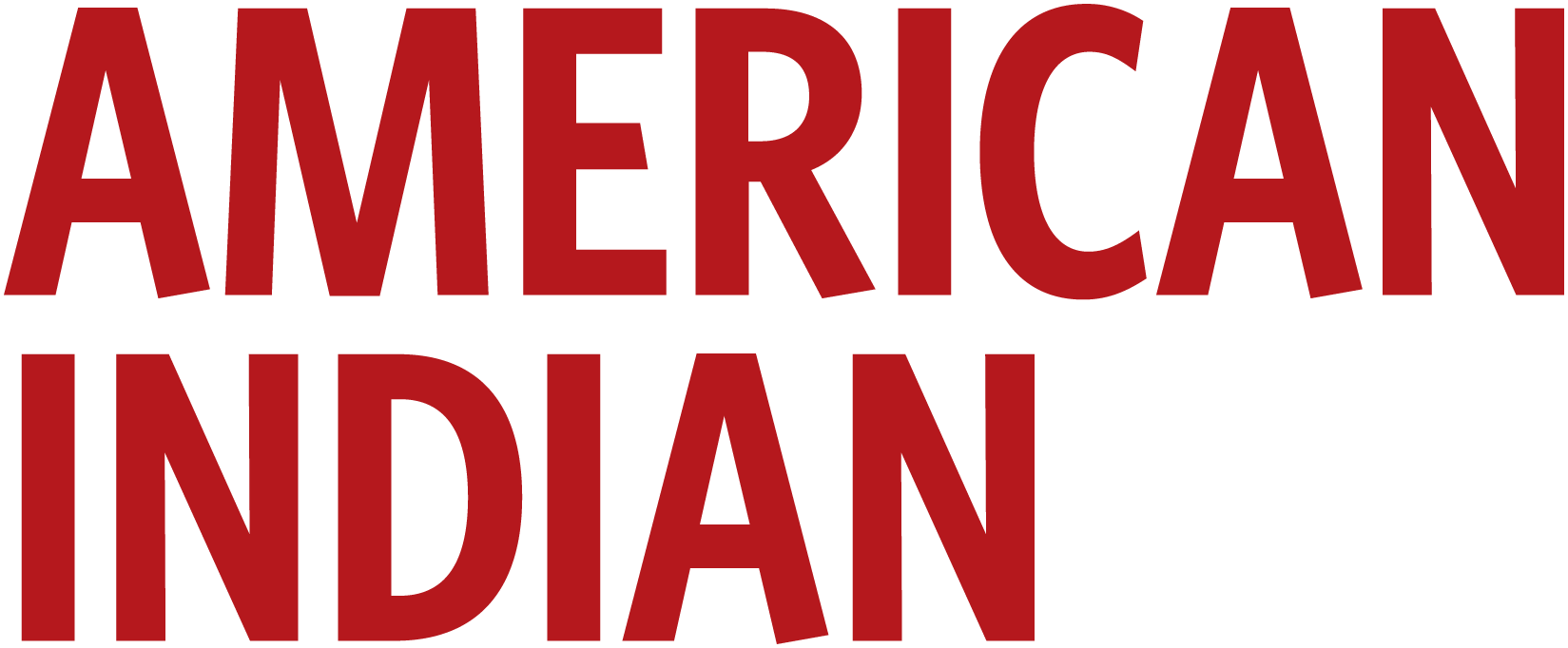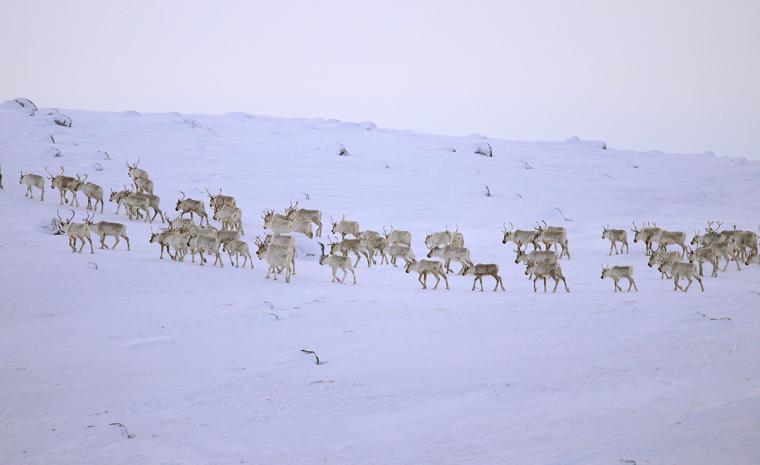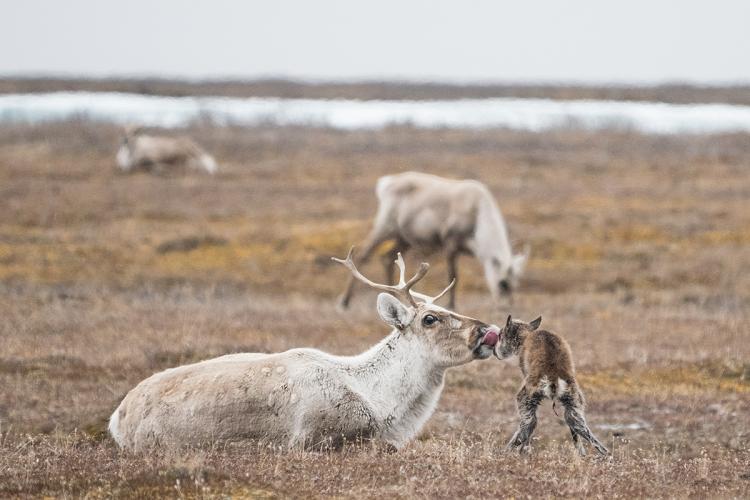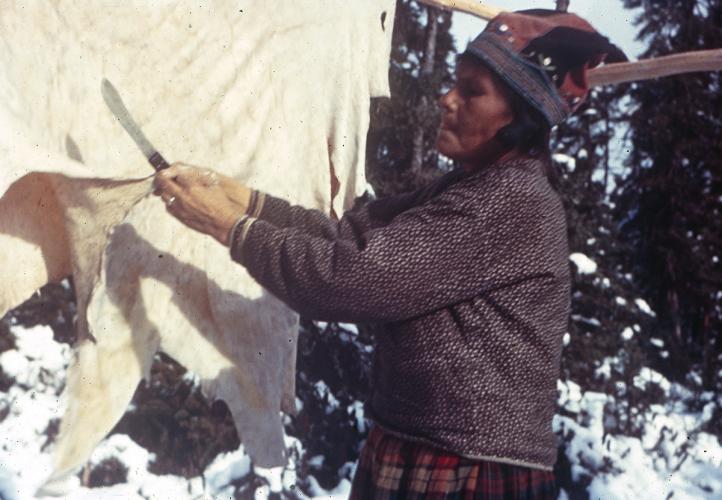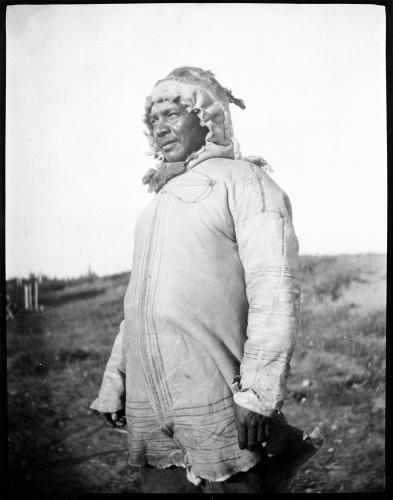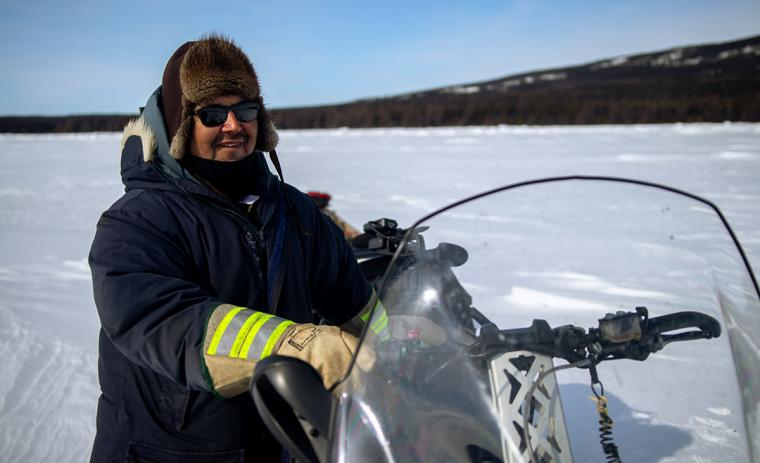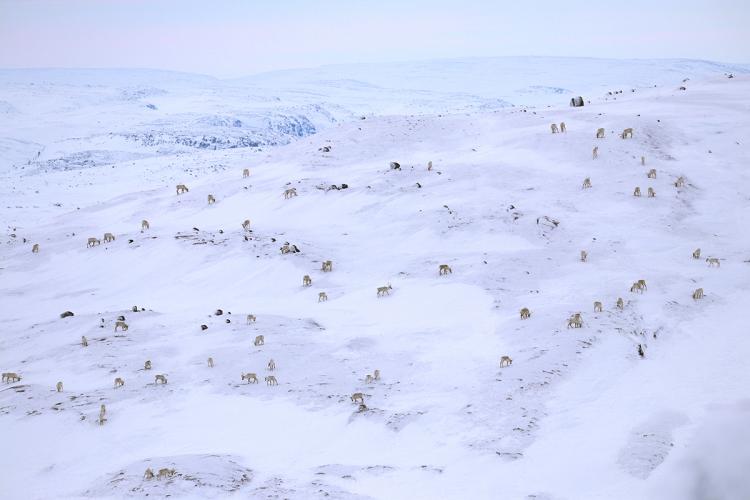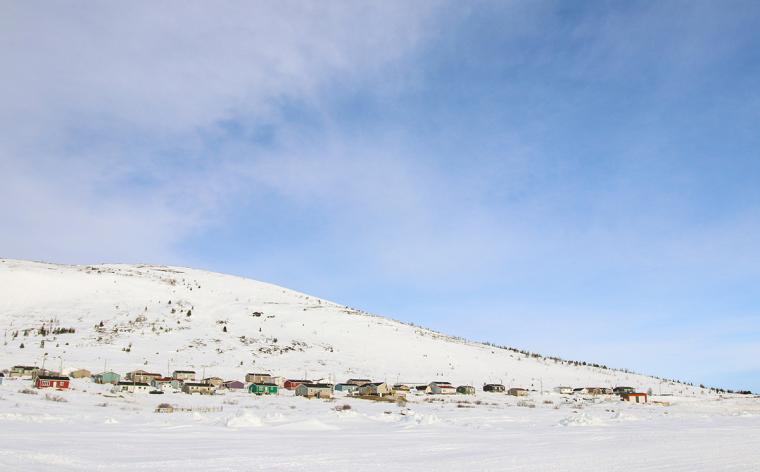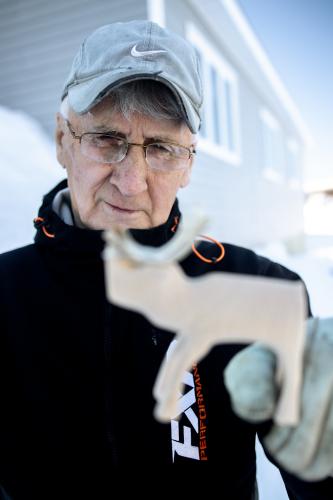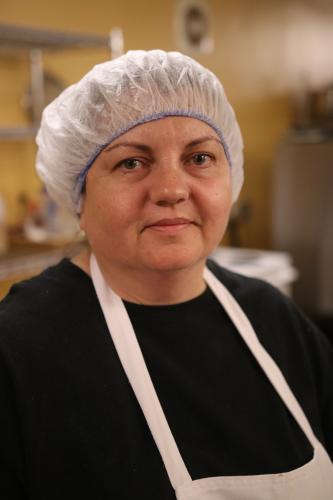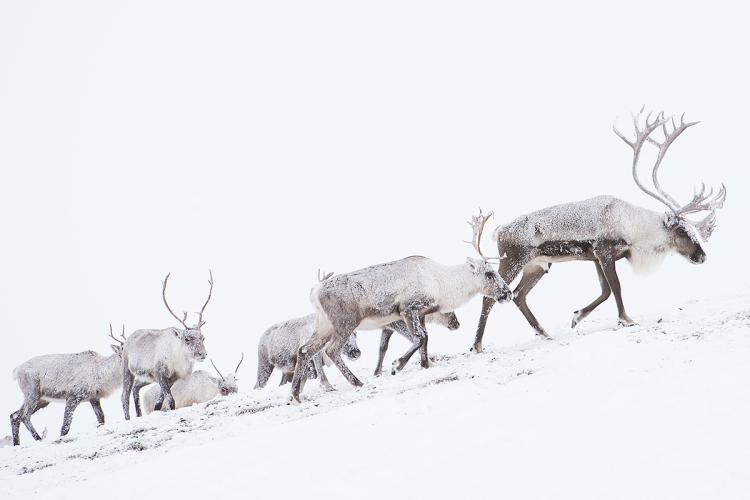Robert Watt shot his first caribou when he was eight years old. A small group from his Inuit community of Kuujjuaq in northern Quebec had traveled upriver toward the confluence of the Larch and Caniapiscau Rivers to hunt the animals. The memory of that day almost four decades ago still lingers. “The air was crisp and cold,” recalled Watt. “You could see your breath.”
Caribou have been an intrinsic part of life for Indigenous peoples in the Arctic and sub-Arctic regions of North America, including the Inuit, whose villages pepper Greenland, northern Canada and Alaska. The animals were a primary source of meat for food, hides for clothing, and antlers for tools, but hunting them also transcended generations as well as bonded families and communities.
Watt’s father taught his son how to shoot a rifle. Others from his community showed him how to skin and butcher the carcass and how to use its meat, hide, bone and antlers. To mark the special event, that first caribou also became a gift to his “maker”—the midwife who attended his mother at Robert’s birth. His mother invited all the women in his extended family to a feast. They sat around eating and telling stories. “Your maker makes you feel special,” he said. “They were proud of me. I was on top of the house, throwing gifts to the guests. It was a rite of passage.”
Inuit people see caribou as fellow inhabitants of the same landscape, closely integrated with the humans who follow and hunt them. The caribou are part of their identity. So if they are gone, part of them and their culture also disappears. Yet during the past 30 years, caribou numbers around the circumpolar world have been declining, not only in North America but in Siberia and Scandinavia as well.
Broken Bonds
When Watt was a boy during the 1970s, lots of caribou roamed the landscape. Migrating tundra caribou covered the hillsides and flowed right past towns like Kuujjuaq in Quebec and Rigolet and Hopedale in Newfoundland and Labrador. Numbers of the animals were low in the 1950s and 1960s but then rose. Between the 1950s and the 1990s, for instance, the George River herd, which historically ranged from northern Quebec to Labrador, expanded from 15,000 animals to more than 800,000. Others of Canada’s several dozen herds of tundra and woodland caribou have remained more or less stable while others have varied.
Then, during the past two decades, caribou populations in Newfoundland began to plummet, from approximately 95,000 animals to current estimates of 29,000. From the mid-1990s to about 2010, the George River herd crashed by 99 percent to less than 8,000.
The caribou, like many animal populations, have natural fluctuations in numbers, but this was something different. According to Sherbrooke University biologist Marco Festa-Bianchet who has studied the animals for a dozen years, a complex, interlocking web of human activity has exacerbated those natural fluctuations in recent decades. Caribou avoid disturbed areas, so logging, mining, building power lines, and mining oil and gas have changed and compressed the caribou’s environment markedly.
Once logging or forest fires remove standing trees, young trees and brush start growing in their stead, and moose and deer move in to forage on them. Wolves, bears and coyotes follow the moose and deer. Roads, cross-country ski tracks and snowmobile trails also serve as paths for predators to enter caribou territory. The predators’ population then swells, and they start preying on caribou. For instance, on the island of Newfoundland, bears and coyotes are the primary predators of caribou calves, limiting the number of calves that reach reproductive age, said a recent report from the government of Newfoundland and Labrador.
The provincial government responded to the herd’s collapse with the bluntest of instruments, given the extreme decline of the herd. Hunting caribou was forbidden in the province beginning in 2013, a decision made with only minimal input from the Inuit themselves and with little regard for its cultural impact, said Jamie Snook, executive director of the Torngat Wildlife, Plants and Fisheries Secretariat in Happy Valley-Goose Bay, Labrador. The ban was expected to last for five years, but as the population has yet to stabilize and grow, it remains in effect.
“The goal of the hunting ban on Labrador’s migratory caribou is to prevent the complete loss of George River caribou and to allow the herd to recover so Indigenous communities can carry out caribou-related traditional activities without jeopardizing the sustainability of the herd for future generations,” said the province’s Department of Fisheries, Forestry and Agriculture, in a statement from spokesperson Linda Skinner.
Today, young Inuit such as Nicholas Flowers, a college student from Hopedale, Labrador, are denied the experience that Robert Watt remembers so well. “I never got to go on a hunt,” said Flowers with regret. “Bringing back food for your family brings something beautiful into a hunter’s life, and that first caribou was an important milestone for a young person. I’m sad not to have had that opportunity. Kids these days have no idea of what that would feel like. But I just hope I can go when the ban is lifted.”
The caribou hunt wasn’t just the equivalent of a trip to the grocery across a snowbound landscape in Nunatsiavut, the Inuit autonomous region in northern Labrador. “We went out from January through March, after the rivers and lakes had frozen over solid and before the spring mating season began,” said Inez Shiwak, a Canada Post worker and an Inuit community researcher. “Whole families—fathers, mothers, brothers, sisters—went on the expedition. It was beyond food. The parents were passing along tradition and knowledge to the next generation.”
Hunting caribou meant traveling—once by dogsled and now by snowmobile—from the home community to traditional hunting grounds along caribou migration routes. On the way, Inuit hunters would stop to visit friends or relatives in other tiny communities scattered across the landscape. Besides seeking out and shooting caribou, young Inuit learned from their elders the topography, names of places unmarked on maps and traditional travel routes. They observed the dark green of the trees, the shapes of the hills and the curving banks of the rivers. They learned where other creatures, those fellow denizens of the north, walked or flew or swam.
The hunt developed character, too. As Inuit activist Sheila Watt-Cloutier put it in a 2006 interview with the Toronto newspaper the Globe and Mail, “Young people are prepared for life through the hunt—how to be patient, to be bold under pressure, to withstand stress, to focus, be tenacious, how not to be impulsive, to be courageous, to exercise sound judgments and, ultimately, how to be wise.”
Sharing the Bounty
The Inuit feasted on caribou in myriad ways. Caribou meat might be roasted, fried, stewed or turned into soup or even a pizza topping. One particular delicacy were ringalls, batter-coated patties of chopped caribou meat. Just the thought of “nikku,” or dried caribou meat, brings back memories to elderly Inuit. “We ate caribou almost every other day and always for Sunday dinner.” said Shiwak. “We can’t do that anymore. We’re more dependent now on store food.”
Watt’s experience on his first hunt was typical in another way. The caribou a hunter shot was not destined solely for his family. The meat was shared with fellow communities, and those people shared the proceeds of their hunting trips as well. That culture of exchange and the communal, storytelling meals that followed cemented communities together. As the caribou grew scarce, sharing became more difficult, threatening those critical social ties. “What worries me is not being able to do what you’re doing,” said Shiwak. “If you’re not sharing, you’re not doing your culture justice.”
The hunting ban also affected the physical health of the Inuit. Caribou meat was a prime source of iron in their diet, and its loss has led to insufficient levels of the mineral among some Inuit, said Judy Voisey, an Inuit instructor who teaches cooking classes and is a provincial career advisor with the Women in Resource Development Corporation in Happy Valley-Goose Bay. She now teaches ways to prepare traditional foods such as partridge rice soup and smoked or baked stuffed arctic char and lingonberry, blueberry or redberry or bakeapple jam to go with “toutons” or “panitsiaks,” a kind of fry bread. But given the importance of the meat to her people, she said, “It’s hard to do classes without caribou.” She used to teach young people how to cook the heart, tongue and marrow of caribou, delicacies prized by the Inuit. She would tell her students to “not waste any of it.”
When the animals were hunted, nothing was wasted. Bones and antlers were carved into tools or sculptures. Hides were fashioned into clothing. But without the chance for elders to teach the young how to prepare the hide and sew it into garments, those skills will be lost.
Hunting terminology, geographic place names and parts of the caribou known in the Inuit languages are also fading from memory as youth don’t go out on a hunt on the land. “My grandfather and great-grandfather would have known those names,” said Flowers. “If you’re not hunting, you lose those terms.”
“The ban puts cultural continuity at risk, not just for 15-year-olds but also for those in their 20s and 30s and 40s,” said Snook. “The longer the ban, the more that’s at risk.”
Keeping Them in Their Sights
Although Inuit may not be allowed to hunt the caribou, they can still experience sharing the landscape with these magnificent animals. The Torngat Secretariat has begun a pilot project that brings together elders with youth, who together go out and track—but not kill—caribou. The youth can therefore gain the skills associated with crossing the land while fishing for char and hunting for permitted game such as seals, ptarmigans, ducks and geese.
Others have argued for allowing a minimal cultural hunt that would take very few animals but give young Inuit the opportunity of traversing their homelands, seeing the reality of the kill, tasting the meat and learning how to use the rest of the animal. “Even one experience as a child would last a whole life,” said Flowers.
While the Inuit in Labrador reluctantly agreed to the hunting ban at the time, they came to feel that their knowledge and opinions went mostly unheard by the provincial government. If and when the status of the ban is reconsidered, Inuit and other Indigenous peoples want political authorities to accept the validity of their way of knowledge and greater involvement in future decisions about managing the herds. The Inuit have been here season after season, year after year, generation after generation. A non-Indigenous researcher, by contrast, might come north once every few years.
“Western science has a conceit that it is the only way to understand the world, but it is only 500 years old,” said Ashlee Cunsolo, vice-provost of the Labrador Campus and dean of the School of Arctic and Subarctic Studies at Memorial University in Happy Valley-Goose Bay. “Indigenous peoples have spent thousands of years observing their environment, learning about it, adapting to it and caring for it as an integrated whole,” said Cunsolo. “For thousands of years, the land gave birth to people and caribou, and they grew up together.”
One example of how the Inuit are developing and expressing their own understanding of the caribou came recently in the form of a film called “HERD: Inuit Voices on Caribou.” Indigenous residents of the Nunatsiavut and NunatuKavut regions in northern Labrador initiated the project to highlight the knowledge and vision of their communities. The resulting community-led, research-based documentary morphed into director David Borish’s Ph.D. thesis at the University of Guelph. Dozens of Indigenous people, from elders to young adults, were interviewed in the film, including Flowers and Voisey. The film and the peer-reviewed articles that were published later as a result represent a slowly growing collaborative research trend in which the people who are the focus of a study are also full participants in its creation.
A theme frequently expressed in the film is the palpable sense of loss among the Inuit when recalling the caribou that were once a central part of their lives. One Inuit elder, Sarah Baikie, says, “It’s not only the loss of a source of food. When you think of your grandchildren, part of their heritage is gone. The younger generations will never be able to enjoy that. It’s up to us older people to explain, but it’s not the same as being there and doing it yourself.
The decline of the herd and the hunting ban have left a swirl of stress in their wake, something that Cunsolo has called ecological grief: “A rational response to changes in the land, it is the grief experienced due to endured or anticipated ecological losses, the disruption of environmental knowledge and the loss of place-based identity due to environmental changes.” Shiwak, a co-producer on the film, said “When you’re out on the land you feel free. . . . You still have problems, but you come back with a new perspective.”
If the bond between Inuit and caribou was strained by scarcity and government edict, the ban created other strains as well. “Some Indigenous groups believe that hunting is their right and have taken the risk to harvest caribou, but most others fear violating the law,” said Snook. Surreptitious hunting is also a loss to research, he said. Information like an animal’s size, weight, condition and location won’t be recorded, undermining work for their conservation and restoration.
In the wake of the hunting ban, the governments of Newfoundland and Labrador, Quebec and Nunatsiavut survey the George River Caribou herd every two years. In July 2022, they reported that the herd population remains at a vulnerable low, with an estimated 7,200 caribou—a decline of 11 percent since 2020 and more than 98 percent since 2001. However, the report stated that “the continued illegal harvest of George River caribou by a relatively small number of people continues to delay and threaten herd recovery.”
Taking as few as 5 percent of the herd each year reduces the expected rate of population growth substantially because the loss of a single female caribou means the absence of many more offspring over subsequent generations, said Festa-Bianchet. “The few caribou that are there now are the key to herd recovery,” he said. “Any caribou you take today means maybe 15 or 20 fewer caribou that your children will be able to take in a sustainable harvest in 20 or 25 years. Even one that is killed now will slow down or prevent that recovery and it will take more years to the time when there can be a decent harvest.”
For the moment, the Inuit embrace the stories of their elders and their own recollections of the caribou as they await the return of the animals in the numbers of old. “I remember my grandmother saying that in years gone by there were other times when there were no caribou,” said Robert Watt, resting his hopes on words he heard in childhood about natural boom-and-bust cycles.
Voisey worries that young people today will never develop a taste for caribou because they never ate it growing up. For her, just hearing the word “marrow” evokes memories of its taste and its central place in her childhood, memories she fears may be lost in time. “My son won’t have those memories,” she said. “I want to share marrow with my grandchildren.”
